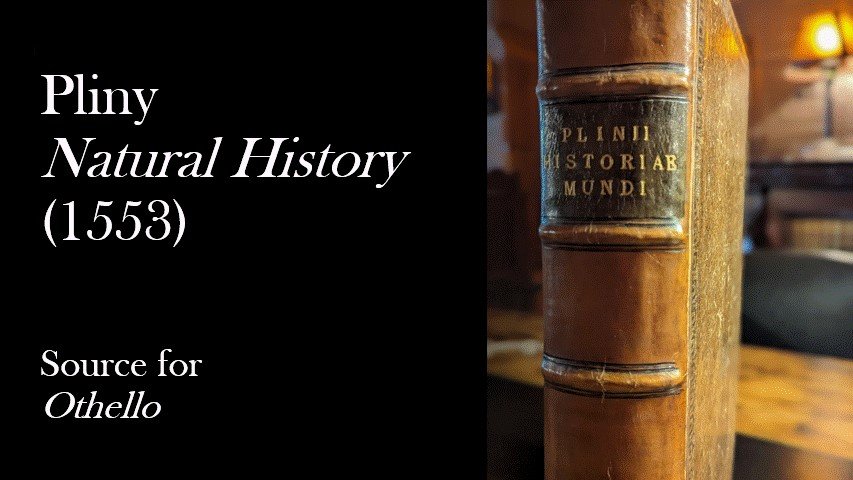Pliny's Natural History (1553)
ONLY TWO KNOWN COPIES
PLINIUS Secundus, Gaius (c. 23-79)
C. Plinii Secundi Historiae mundi libri XXXVII majore quam hactenus unquam, studio, fide, religione emedati, adjectis ad marginem succinctis . . . una cum indice totius operis copiosissimo. Lugduni, Apvd Ioannem Frellonivm. M.D.L.III.
Pliny the Second’s History of the World in 37 books, with greater study, faith, and religion than ever before, added to the margin . . . together with the most copious list of the whole work. Lyon: John Frellonium, 1553.
Pliny's Natural History is Shakespeare's source for the famous description in Othello of "men whose heads grow beneath their shoulders." See Kenneth Muir, Shakespeare’s Sources (London, 1957), p. 127.
Although there were translations of Pliny into French and English, some scholars have argued that Shakespeare read Pliny in Latin. See T. W. Baldwin, “A Note upon William Shakespeare’s Use of Pliny,” in Essays in Dramatic Literature (London, 1935), pp. 157-82.
Folio. 3 parts in one vols. A2-A4 B-C4 a-z5 A-Z5 AA-ZZ4 [Con]2 m4; ??l.; [34], 679, [236] p. Title-page vignette. Medium brown calf, blindtooled border on both boards.
Provenance: Inverchapel bookplate.
The National Union Catalog of Pre-1956 Imprints lists only two known copies, not including the present one.
References: NUC: 461, 671-90 [NP 0424260]. Not in USTC.
ONLY TWO KNOWN COPIES
PLINIUS Secundus, Gaius (c. 23-79)
C. Plinii Secundi Historiae mundi libri XXXVII majore quam hactenus unquam, studio, fide, religione emedati, adjectis ad marginem succinctis . . . una cum indice totius operis copiosissimo. Lugduni, Apvd Ioannem Frellonivm. M.D.L.III.
Pliny the Second’s History of the World in 37 books, with greater study, faith, and religion than ever before, added to the margin . . . together with the most copious list of the whole work. Lyon: John Frellonium, 1553.
Pliny's Natural History is Shakespeare's source for the famous description in Othello of "men whose heads grow beneath their shoulders." See Kenneth Muir, Shakespeare’s Sources (London, 1957), p. 127.
Although there were translations of Pliny into French and English, some scholars have argued that Shakespeare read Pliny in Latin. See T. W. Baldwin, “A Note upon William Shakespeare’s Use of Pliny,” in Essays in Dramatic Literature (London, 1935), pp. 157-82.
Folio. 3 parts in one vols. A2-A4 B-C4 a-z5 A-Z5 AA-ZZ4 [Con]2 m4; ??l.; [34], 679, [236] p. Title-page vignette. Medium brown calf, blindtooled border on both boards.
Provenance: Inverchapel bookplate.
The National Union Catalog of Pre-1956 Imprints lists only two known copies, not including the present one.
References: NUC: 461, 671-90 [NP 0424260]. Not in USTC.
ONLY TWO KNOWN COPIES
PLINIUS Secundus, Gaius (c. 23-79)
C. Plinii Secundi Historiae mundi libri XXXVII majore quam hactenus unquam, studio, fide, religione emedati, adjectis ad marginem succinctis . . . una cum indice totius operis copiosissimo. Lugduni, Apvd Ioannem Frellonivm. M.D.L.III.
Pliny the Second’s History of the World in 37 books, with greater study, faith, and religion than ever before, added to the margin . . . together with the most copious list of the whole work. Lyon: John Frellonium, 1553.
Pliny's Natural History is Shakespeare's source for the famous description in Othello of "men whose heads grow beneath their shoulders." See Kenneth Muir, Shakespeare’s Sources (London, 1957), p. 127.
Although there were translations of Pliny into French and English, some scholars have argued that Shakespeare read Pliny in Latin. See T. W. Baldwin, “A Note upon William Shakespeare’s Use of Pliny,” in Essays in Dramatic Literature (London, 1935), pp. 157-82.
Folio. 3 parts in one vols. A2-A4 B-C4 a-z5 A-Z5 AA-ZZ4 [Con]2 m4; ??l.; [34], 679, [236] p. Title-page vignette. Medium brown calf, blindtooled border on both boards.
Provenance: Inverchapel bookplate.
The National Union Catalog of Pre-1956 Imprints lists only two known copies, not including the present one.
References: NUC: 461, 671-90 [NP 0424260]. Not in USTC.





